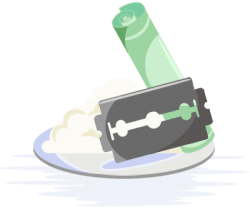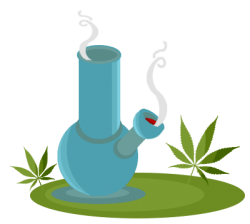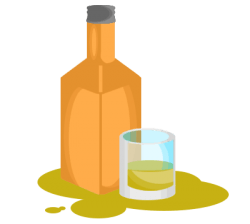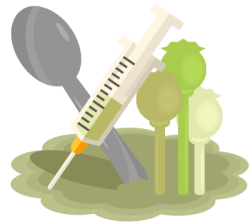A
Adderall: Because teens and young adults are most likely to have a prescription for the pills due to the high rate of ADHD in this population, there is a great deal of abuse in high schools and colleges.
Ambien: Ambien is a sedative-hypnotic medication, and it works inside the human body in a manner similar to benzodiazepines like Xanax.
B
Benzodiazepines: Benzodiazepines belong to the class of prescription drugs known as tranquilizers. They are among the most commonly prescribed pharmaceutical drugs in psychiatric medicine.
C
Crack Cocaine: Due to its potential for abuse, cocaine is classified as a Schedule II drug, which means that it is susceptible to abuse but also has a recognized medical purpose.

Users of cocaine may be bereft without the drug, even after just one hit, and they may chase that high by taking dose after dose in rapid succession, doing an intense amount of damage with each and every hit.
Crystal Meth: Meth is a water-soluble powder that can be snorted, smoked, or dissolved in solution and injected into the veins. Over time, crystal meth abuse can cause serious damage to the heart and brain.
D
Designer Drugs: The term “designer drugs” refers to a range of synthetic substances that are created in labs. These drugs will vary in composition in every batch, making them exceedingly dangerous for users.
Dilaudid: Dilaudid is an opiate drug, meaning that it has a chemical structure that’s similar to opium, which is one of the oldest and best-studied drugs known to man.
E
Ecstasy: Regular use of Ecstasy can alter your brain chemistry, causing depression, anxiety, dependence and addiction.
F
Fentanyl: Fentanyl, like the other opioids, functions as a pain reliever, depressing pain receptors in the brain and body.
G
GHB: GHB is used not only to get high or alter sensory perceptions but also to take advantage of unsuspecting partiers. GHB has earned a reputation as a “date rape drug”
H
Halcion : Halcion, also known by the generic name triazolam, is a powerful sleep medication that should be used only on a very short-term basis.
Heroin: This is one of the most powerful drugs available in the illicit marketplace, capable of causing very persistent cases of addiction with breathtaking speed.
Hydrocodone: The most commonly prescribed opioid narcotic, hydrocodone, is designed to function similarly to morphine, as an analgesic for pain relief.
I, J, K
Ketamine: This powerful, hallucinogenic drug is illegal for recreational use in the United States, but most people who take this drug get it from their friends and acquaintances when they see them at clubs, raves or parties.
L
Lortab: Lortab is a highly addictive type of prescription pain reliever. Any purported benefits of abusing Lortab are not worth the risks, which can include death.
LSD: In spite of the devastating psychological, physical and legal repercussions of using LSD, millions of people have continued to use it — often with tragic results.
M
Marijuana:
People who use this drug are sometimes exposed to very serious, and very complicated, forms of addiction that can be difficult to cure.

Methadone: Methadone is still widely used as for pain control and opiate dependency. However, when the drug is abused, this narcotic pain reliever can be addictive in its own right.
Morphine: This drug has the ability to amend the way the brain responds to pleasure, and this change could make an addiction likely.
N
Nembutal: Benzodiazepine medications like Nembutal are often targets for people with addictive tendencies, as these drugs can produce an intense feeling of euphoria paired with a sensation of relaxation.
Neurontin: Neurontin is an excellent example of a drug that may be safe when used under the care of a prescribing doctor, but that can be dangerous when abused by non-prescribed users.
O
OxyContin: People who develop an addiction to OxyContin likely never planned to get hooked. In fact, it’s likely that people like this took the pills recreationally just one time, hoping to have a little fun.
Opiates: The recreational use of opiates can quickly lead to physical and psychological dependence – the first step in a deadly cycle of addiction
P
Percocet: Percocet is a combination of both the narcotic pain reliever oxycodone hydrochloride and the non-narcotic pain and fever reducer acetaminophen.
Pregnancy: Abuse of or dependence upon any drug of addiction can be harmful to a woman in pregnancy just as they would be if she were not pregnant.

Prescription drug abuse can be defined as taking a prescription medication that you have not been prescribed or misusing a medication that you have been prescribed.
Q, R
Restoril: Restoril is a specific type of hypnotic drug that falls into the classification of benzodiazepines. These are powerful drugs that can be perfectly safe when used exactly as directed.
Rivotril: Rivotril is prescribed as an anticonvulsant, although it is also a drug of abuse for many individuals looking to increase the effects of heroin and other opiate drugs.
S
Salvia: Salvia divinorum, can produce powerful symptoms in those brave enough to take it, and those people who do experiment with the drug may have experiences they wish they could forget.
T, U
Ultram: Marketed as a relatively safe painkiller with a low potential for addiction, Ultram (its generic name is tramadol) is prescribed for the relief of moderate to severe pain.
V
Valium: Valium has a sedative effect in users that many find addictive. This effect may be chased through increased use of the drug or abuse of the pills.
Vicodin: While Vicodin can present effective, short-term pain management for many individuals under a physician’s care, its effect on the brain often leads to chemical dependency.
W, X, Y, Z
Xanax: People who have an addiction to Xanax, are playing a dangerous game that could cost them their health and their happiness.
A
Therapy can make a major difference in the life of someone with an unhealthy attachment to alcohol.

Alcohol Treatment: The compulsive need to continue drinking in spite of the harmful consequences is a sign that you or someone close to you needs alcohol treatment. It’s no exaggeration to say that an effective, comprehensive alcohol rehab program could literally save your life.
Ambien: Without treatment, those who continue to abuse Ambien can find that their sleep issues worsen rather than get better.
Anxiety Treatment: Depending upon the specific type of anxiety an individual experiences, the treatments can range from medication and psychological counseling to long-term inpatient care at a residential facility.
B, C
California Treatment: Nowhere in the country beats California for all it has to offer to those in recovery from any medical disorder.
Cocaine: Without immediate help, cocaine abuse and addiction can be deadly.
Cognitive Behavioral Therapy: Some of the most powerful weapons experts can use in the fight against addiction don’t involve medications at all. Cognitive behavioral therapy (CBT) is one of these therapies.
Crystal Meth: People feel as though they’re on a speeding train of addiction, with absolutely no control. Rehab is designed to stop that train, giving people control over their lives once more.
D
Depression Treatment: With so many individuals suffering from depression and the likelihood that depression can lead to other conditions, such as alcohol and drug addiction, it is important to understand what this disease is and how it can be treated.
Drug Detox: Many people struggle in the days that immediately follow the decision to get sober. During this withdrawal process, the help of experts in a drug detox program can be absolutely vital.
Dilaudid: Dilaudid is a painkiller containing hydromorphone, a powerful synthetic opioid derived from morphine, which is found in the opium poppy.
Dual Diagnosis Treatment: Dual diagnosis issues are best treated in comprehensive programs that blend addiction care with mental health care.
E, F, G
Eating Disorders & Addiction: Each person who has an eating disorder likely has an origin story that’s just a little different. But no matter how the problem began, treatment can make it better.
H

There are a number of methods experts can use in order to end the cycle of heroin addiction and help people to see the value of a safe and sober life.
I, J, K, L
Intervention: These conversations may be an effective way to make the addiction cycle end for good.
M
Marijuana: Many believe marijuana is harmless because the drug is natural. Many experts disagree, and suggest the average marijuana addict needs the help of a qualified treatment program.
Opana: Opana is a branded prescription pain reliever and member of the opioid family.
N, O
Opiates: Opiate addiction recovery programs begin with detoxification. This medically supervised process ensures that people get sober in a safe, controlled environment.
OxyContin: The best OxyContin treatment option for your addicted loved one will depend upon their needs in recovery.
P, Q, R
Prescription Drug: Unfortunately, many prescription drugs can be remarkably addictive, and sometimes, people need sophisticated treatment programs in order to recover.
S
Sober Living: An addicted person who wants to change might enter a sober living community. Here, the person can learn more about the sober lifestyle, and develop skills that can make that lifestyle easier to maintain over the long term.
T, U
12 Step Programs: Twelve-step treatment began with Alcoholics Anonymous, and Alcoholics Anonymous sprang from the principles of a religious organization called the Oxford Group.
V, W
Valium: We can provide intensive therapies for Valium addiction, including group therapy, individual therapy and support group work.
Vicodin: There are a number of treatment options available. A combination of services that address both the physical and psychological issues associated with opiate addiction are recommended.
X, Y, Z
Xanax: There are a number of wonderful therapies available that could help people with a Xanax addiction to take control, so they can live lives that aren’t controlled by the abuse of drugs.
About Us
About Us: Unlike traditional treatment centers that supply only a one-size-fits-all treatment module that has remained unchanged for decades, we utilize cutting edge therapeutic treatments and evidence-based practices to create a unique healing plan for each patient.
Affordable Drug Rehab: Axis Residential Treatment provides a top rated treatment program combined with luxurious accommodations and highly trained staff–at an affordable price.
Admissions: Call our 24 hour toll-free helpline at 866-737-3570. Our trained admissions coordinators will walk you through the admissions process and answer any questions you may have.
Contact Us: Our admissions hotline is staffed 24 hours per day, 7 days per week to ensure that someone is waiting when you decide to call. You can also send us a message
Facilities: Learn more about our four locations.
Insurance: Axis Residential Treatment accepts most insurance coverage or private pay. Our admissions counselor will provide a free insurance verification 24 hours a day, 7 days a week.
Referring Professionals: As a referring professional, choosing the right drug and alcohol rehab requires a high level of care and experience in treating individuals suffering from addiction and mental health problems.
Staff: The sole focus of our staff is to assist each patient through his or her recovery experience from beginning to end, making sure that everyone has exactly what they need to get the most out of recovery and create a new life.








